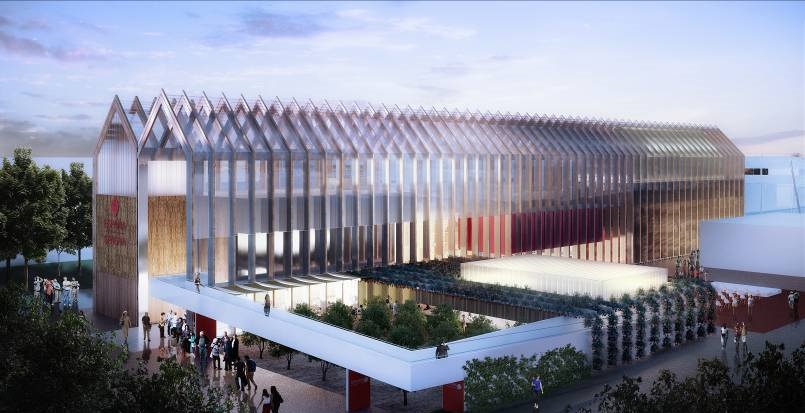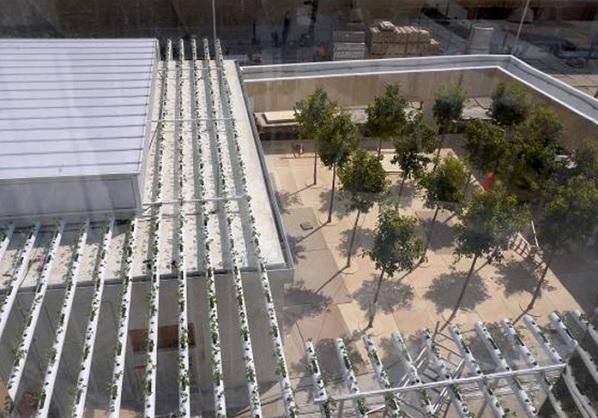Breaking Travel News investigates: Spanish cuisine comes to Expo Milano

The theme of Expo Milano 2015 is ‘Feeding the planet, Energy for life’, and reflects on some of the biggest challenges faced by Man – hunger, malnutrition, food health and safety and sustainable agriculture – within the framework of the UN Millenium Development Goals for 2015.
Spain is very committed to the theme of this universal exhibition and the central ideas developed in the Spanish Pavilion are related to the five central themes of Expo Milano 2015.
Spain’s contribution to the evolution of food has been of key importance throughout history.
This is why the Spanish Pavilion places special importance on the role of the country in the acclimatisation and diffusion of plants from different continents in Europe, as well as the spreading of plants grown in Spain to other continents.
The history of the spreading of agricultural plants from America across Europe is of particular relevance, as is the introduction of Iberian livestock to the Americas.
The Spanish Pavilion displays the most innovating technological experiences in crop growing, irrigation, transformation, distribution and processing of foods which show cutting edge trends in food production techniques.
Olive oil, wine, Iberian ham, fruit and vegetables, as well as fish, shell fish and canned foods are the leading products which the Spanish food and agriculture industry has to offer, and are noted for their quality, quantity and diversity.
Spain’s basic and raw materials are second to none and tradition and innovation blend harmoniously during the process of elaboration and distribution.
Moreover, the Spanish Pavilion shows how our country is a perfect blend of traditional agricultural and livestock production, perfectly adapted to the nature of the country, with other innovating and more intense production methods, optimising resources and offering top quality products which can meet even the most demanding international standards.
Emphasis is also placed on organic production and food processing, which in turn lead to the rediscovery of certain traditions and products which are adapted to the local environment and reduce the impact of food production on the balance of nature.
The Spanish stand also offers a good selection of its important contributions to research and innovation in modern day cooking and gastronomy.
The Mediterranean diet, guarantee of quality and diversity; the deliciousness of our traditional dishes, avant-garde cuisine which marks trends on the worldwide stage and food as a backdrop for socialising and fun are the main focal points of the pavilion, offering visitors a foretaste of the diversity of gastronomic experiences linked to a new kind of tourism based on experiences and sensations.
One of the objectives of our exhibit is to show how Spain is contributing to the Millenium Goals, reducing hunger in the world and guaranteeing food safety for future generations.
Spanish Pavilion
The Spanish Pavilion is basically inspired by a glasshouse but with the shape of an “hórreo” or Galician Grain Store.
It is a double sided structure which represents the merging of the two qualities that our country exports: Tradition and Innovation.
Located at the confluence of the two main avenues of the Expo venue – Cardo and Decumano – the pavilion is the perfect blend of simplicity and technical complexity which combine to create a functional, themed Exhibit.
Built with a clear and contained geometrical concept in mind, it forms two rows of wooden and stainless steel porches.
These porches represent, respectively, the fusion of tradition and innovation.
The dual nature of the pavilion creates an attractive and flexible area which includes an open space, an orange grove – an example of another element in Spain’s cultural identity.
Underneath the arches in the innovation zone, we find metal surfaces representing oil, wine and olives, whilst under the porches on the “traditional” side, the surfaces are covered in materials such as cork, esparto grass and wood from barrels.
Organised and managed by Acción Cultural Española – a public organisation responsible for Spain’s exhibits at universal and international exhibitions - the Spanish Pavilion was designed by studio b720 Fermín Vázquez Arquitectos and has a total area of 3,300m2.
Divided into three levels, the only area in the pavilion deliberately closed-in and located indoors is the main exhibit The Language of Taste.
In addition to the actual exhibition area, the pavilion also has a gourmet shop, tapas bar, restaurant, public square and multi-function auditorium.
The pavilion has been mainly made using recyclable and natural materials and is basically prefabricated.
It is a semi-open structure and thus makes good use of the natural climatic and environmental conditions for both natural lighting and ventilation.
The Spanish Pavilion was assembled by a system which uses large, solid wood panels which have been cut to exact size.
A total of 8,000 m2 of cross laminated panel was used, made from sustainable pine or fir boards.
The construction process was undertaken by “Empty”.
This company uses a drywall system which is easy to assemble and dismantle.
The Spanish Pavilion expects to attract over 2.2 million visitors, with 12,000 visitors per day.

The journey of taste
The journey of taste is an installation art exhibit created by Antoni Miralda which constitutes a poetic reflection on food.
A huge suitcase measuring 5 x 4 metres, symbol of the journey to be undertaken, will greet visitors on arrival and is the focal point of this audio-visual piece, created by the versatile artist and representing Food Culture for the Expo theme.
He has called it “a poetic work, a meeting point for interaction which is both a visual reference and an invitation to reflect”.
The journey of taste will captivate visitors with its rich icons, the impact of both visual and food memory.
A further twenty suitcases will accompany visitors on their journey round The journey of taste, the main exhibit located on the first floor.
The food which Miralda has placed inside the big suitcase has been chosen for its cultural and historic significance, its popularity and because all these items are essential ingredients to be found in any Spanish larder.
Each sequence in the videos included in the Journey of Taste has a measured pace, in sharp contrast to the hustle and bustle to be found outside the Spanish Pavilion.
Moreover, each food video invites us to reflect on the theme, using important cultural references which transform into framed works of art.
These have been digitally doctored to allow visitors to explore the imaginary and discover a new kind of imagery.
Pablo Salinas
Melody, rhythm and integration are the three elements which feature in the compositions which the multi-talented musician, Pablo Salinas has created for the Spanish Pavilion.
With the core idea of “teaching through pleasure”, the composer has created both the music for the exhibition The language of Taste and the melody played at the installation art by Antoni Miralda, The Journey of taste.
He is the guitarist and pianist featured in the piece, and was also responsible for the musical arrangements and production of the video.
“At the Spanish Pavilion, music blends harmoniously with architecture, creating an effect of sound immersion which is constantly changing.
“Depending on the location and time, different music related to the journey and the videos can be heard,” explains Salinas, the creator of Sinfonity, the first symphonic guitar orchestra in history.
Salinas’ composition is in perfect symmetry with Miralda’s exhibit, representing a journey through the musical diversity of Spain and its area of influence.
The use of multi-location sound was a genuine technological challenge.
The sources of music are spread out all over the exhibit, with 26 loudspeakers placed in strategic positions, submerging visitors in a well of culture.

Activities
The Spanish Pavilion will offer a wide range of activities at different locations: the auditorium, workshops, green spaces, gardens and orchards.
An extensive programme of events designed to arouse curiosity and reflection amongst visitors regarding the questions posed by feeding the world, while at the same time sharing with them our experience in production, co-operation and food safety.
June 15th is designated by Expo Milano 2015 for the celebration of Spain’s National Day.
On preceding days, a wide range of events and activities has been arranged, including a classical music concert by Sinfonity, the first electric guitar symphony orchestra in the world, conducted by Pablo Salinas, composer of the melodies heard in the Spanish Pavilion.
In turn, the Regions of Spain will also have the opportunity to provide their own programmes: leisure activities and games related to the promotion of local cuisine (show cooking, wine and food tasting); cultural activities and entertainment; tourism promotion, workshops, presentations and business meetings.
Agriculture and food, tourism and diners’ club companies will organise activities aimed at promoting the Spanish production and culinary sector.
Forums, debates, workshops and a series of films related to the theme of this universal exhibition comprise an interesting and varied programme of activities which will attract celebrities from the Spanish world of food and gastronomy to Milan.
Furthermore, the presentation of various different products and tourist destinations will allow visitors to discover some of our most representative foods, such as olive oil, wine, Iberian ham, organic fruit and vegetables or canned fish.
Feeding the Planet
The city of Milan is currently hosting one of the most important world events of the year: Expo Milano 2015.
Some 144 countries and three international organisations will participate in this universal exhibition, the sequel to Expo Shanghai 2010, which hopes to attract over 20 million visitors.
Milan is the capital of the Lombardy region, one of the richest in Italy.
Lombardy is also the most populous region and the main financial and credit services centre in the country.
It is noted for its publishing and news industry.
It is, furthermore, the nerve centre of Italian industry and its economy represents 20 per cent of the Italian GNP.
Milan is the world’s fashion showcase and boasts an important food and agriculture sector, the mainstay of Italian industry.
This sector features a constant capacity to innovate and be competitive, and this has allowed it to adapt to the challenges of a globalised world both quickly and dynamically, offering top quality products with added value.
What is more, Milan is very well connected to the other regions of Italy and neighbouring countries, both by land and air.
It is noted for its tourist attractions, and has a wide range of cultural and nature activities to offer.

